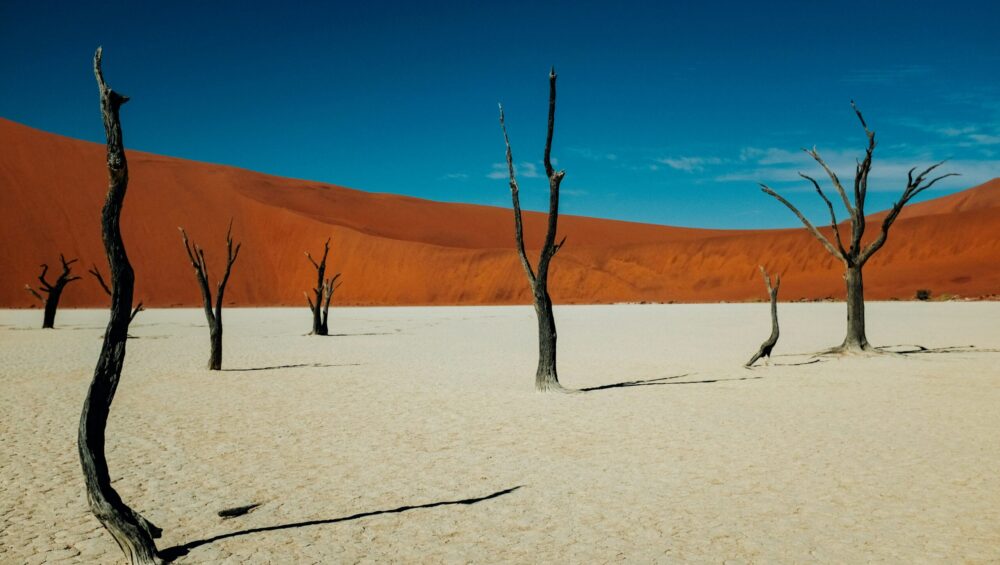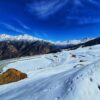Namibia is a land that feels infinite — where the horizon stretches so far, it blurs into the sky.
Everywhere you look, the world seems paused between dream and memory. And when you arrive, it speaks in whispers: wind over sand, footsteps on stone, the low hum of desert heat.
Here, dunes move like waves, mountains glow copper at dawn, and the air feels heavy with space itself. Let’s check out which places you can visit when you are here.
Sossusvlei – The Desert That Burns in Color
At sunrise, the Namib Desert doesn’t just wake up it ignites.
Dunes the height of skyscrapers turn from silver to pink to deep, impossible orange.
The most famous, Dune 45, glows like molten gold under the early sun.
Climb to the top, barefoot in cool morning sand, and watch the light spill across an ocean of dunes. The silence is so complete that even your heartbeat feels loud.
Nearby lies Deadvlei, a salt pan filled with the skeletons of ancient camelthorn trees black, motionless, eternal. Against the backdrop of red dunes and blue sky, it looks like a painting that forgot to move.
There’s no sound here, no sign of time only beauty that asks for nothing.
Namibia Experience → Explore Sossusvlei & Deadvlei with guided sunrise tours
Etosha National Park – A Mirage of Life
Drive north, and the world changes color again.
The white expanse of Etosha Pan stretches endlessly a salt desert where elephants walk like ghosts and herds of zebras shimmer in the heat.
Around its edges, life flourishes: lions doze in the shade, giraffes drink from waterholes under acacia trees, and flamingos gather in flashes of pink after rare rains.
By night, the stars are so bright they seem to hum.
Unlike other safari parks, Etosha feels open — no thick jungle, no noise, just vastness.
Every sight feels earned, every silence golden.
Swakopmund – Between Desert and Sea
Where the dunes meet the Atlantic, Swakopmund sits like a mirage — German architecture, sea spray, and endless sand.
One side is the ocean, the other desert two worlds shaking hands.
Here, adventure hides in plain sight.
Sandboard down golden dunes, ride quad bikes through shifting valleys, or take a scenic flight over the Skeleton Coast, where shipwrecks lie half-buried in sand, slowly disappearing into time.
Then, in the evening, eat fresh oysters by the sea as fog rolls in from the Atlantic.
Namibia has a way of making contrasts feel seamless harsh and gentle, barren and full.
The Skeleton Coast – Where the Ocean Keeps Secrets
It’s easy to see why sailors once called this coastline The Gates of Hell.
Fog drifts across miles of emptiness, dunes spill into the waves, and rusted shipwrecks sit half-buried like forgotten bones.
But stand there long enough, and you’ll feel something unexpected — peace.
The isolation feels sacred, the danger beautiful.
Seals bark in the distance, jackals pad through sand, and the Atlantic breathes heavy and endless.
This is nature stripped bare no crowds, no noise, just Earth in its rawest form.
Damaraland – The Land That Holds Its Breath
Between desert and mountain lies Damaraland, a place of rust-colored ridges and ancient secrets.
Here, time feels old — really old.
You can see prehistoric rock engravings at Twyfelfontein, thousands of years old, or spot desert-adapted elephants wandering through dry riverbeds like living fossils.
In the evenings, the light turns everything bronze.
Locals gather around fires, stories drift into the wind, and the Milky Way unfolds in impossible clarity.
There’s no better place to learn the sound of your own stillness.
NamibRand – Where Stars Outnumber Thoughts
At night, Namibia becomes a galaxy.
The NamibRand Nature Reserve is one of the world’s few certified Dark Sky Reserves, where the stars burn sharp enough to cast shadows.
You lie back, wrapped in a blanket, and realize how small and lucky you are.
The constellations look close enough to touch — Orion, the Southern Cross, and a river of light that feels alive.
If you ever wanted proof that silence can sing, this is it.
People and Culture – Warmth in a Vast Land
Namibia’s landscapes may feel empty, but its people fill it with life.
The Himba of the north, with red ochre skin and braided hair, live in harmony with the land as they have for centuries.
The Herero women wear Victorian-style dresses in bright patterns — a living echo of history.
And in the cities, you’ll find a blend of African, German, and local influences that give the country its unique rhythm.
Wherever you go, smiles come easy. Conversations happen slowly, kindly.
Namibia may look quiet, but its soul is loud with warmth.
When to Visit Namibia
- May to October – Cool, dry season; perfect for safaris, hiking, and stargazing.
- November to April – Hotter and greener, great for photography and desert flowers after rain.
Tip: Visit in June or July for ideal weather — crisp air, golden light, and clear skies.
World Tours curates Namibia experiences that combine red dunes, wildlife, coastlines, and starlit silence — journeys designed for travelers who find magic in stillness.
In Namibia, the world speaks softly — but if you listen, you’ll hear everything.







